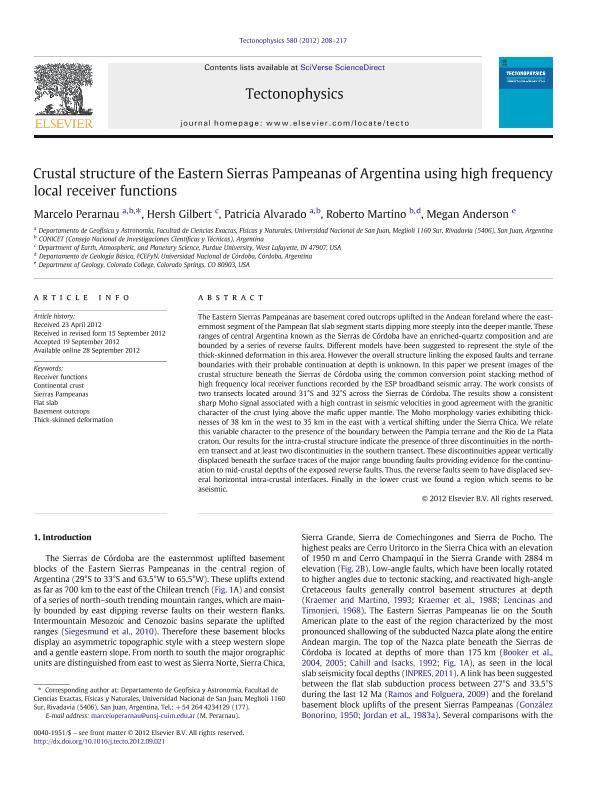Mostrar el registro sencillo del ítem
dc.contributor.author
Perarnau, Marcelo Andres

dc.contributor.author
Gilbert, Hersh
dc.contributor.author
Alvarado, Patricia Monica

dc.contributor.author
Martino, Roberto Donato

dc.contributor.author
Anderson, Megan
dc.date.available
2018-07-13T20:24:53Z
dc.date.issued
2012-12-28
dc.identifier.citation
Perarnau, Marcelo Andres; Gilbert, Hersh; Alvarado, Patricia Monica; Martino, Roberto Donato; Anderson, Megan; Crustal structure of the Eastern Sierras Pampeanas of Argentina using high frequency local receiver functions; Elsevier Science; Tectonophysics; 580; 28-12-2012; 208-217
dc.identifier.issn
0040-1951
dc.identifier.uri
http://hdl.handle.net/11336/52108
dc.description.abstract
The Eastern Sierras Pampeanas are basement cored outcrops uplifted in the Andean foreland where the easternmost segment of the Pampean flat slab segment starts dipping more steeply into the deeper mantle. These ranges of central Argentina known as the Sierras de Córdoba have an enriched-quartz composition and are bounded by a series of reverse faults. Different models have been suggested to represent the style of the thick-skinned deformation in this area. However the overall structure linking the exposed faults and terrane boundaries with their probable continuation at depth is unknown. In this paper we present images of the crustal structure beneath the Sierras de Córdoba using the common conversion point stacking method of high frequency local receiver functions recorded by the ESP broadband seismic array. The work consists of two transects located around 31°S and 32°S across the Sierras de Córdoba. The results show a consistent sharp Moho signal associated with a high contrast in seismic velocities in good agreement with the granitic character of the crust lying above the mafic upper mantle. The Moho morphology varies exhibiting thicknesses of 38. km in the west to 35. km in the east with a vertical shifting under the Sierra Chica. We relate this variable character to the presence of the boundary between the Pampia terrane and the Rio de La Plata craton. Our results for the intra-crustal structure indicate the presence of three discontinuities in the northern transect and at least two discontinuities in the southern transect. These discontinuities appear vertically displaced beneath the surface traces of the major range bounding faults providing evidence for the continuation to mid-crustal depths of the exposed reverse faults. Thus, the reverse faults seem to have displaced several horizontal intra-crustal interfaces. Finally in the lower crust we found a region which seems to be aseismic.
dc.format
application/pdf
dc.language.iso
eng
dc.publisher
Elsevier Science

dc.rights
info:eu-repo/semantics/openAccess
dc.rights.uri
https://creativecommons.org/licenses/by-nc-sa/2.5/ar/
dc.subject
Basement Outcrops
dc.subject
Continental Crust
dc.subject
Flat Slab
dc.subject
Receiver Functions
dc.subject
Sierras Pampeanas
dc.subject
Thick-Skinned Deformation
dc.subject.classification
Meteorología y Ciencias Atmosféricas

dc.subject.classification
Ciencias de la Tierra y relacionadas con el Medio Ambiente

dc.subject.classification
CIENCIAS NATURALES Y EXACTAS

dc.title
Crustal structure of the Eastern Sierras Pampeanas of Argentina using high frequency local receiver functions
dc.type
info:eu-repo/semantics/article
dc.type
info:ar-repo/semantics/artículo
dc.type
info:eu-repo/semantics/publishedVersion
dc.date.updated
2018-07-11T18:03:41Z
dc.identifier.eissn
1879-3266
dc.journal.volume
580
dc.journal.pagination
208-217
dc.journal.pais
Países Bajos

dc.journal.ciudad
Amsterdam
dc.description.fil
Fil: Perarnau, Marcelo Andres. Universidad Nacional de San Juan. Facultad de Ciencias Exactas, Físicas y Naturales. Departamento de Geofísica y Astronomía; Argentina. Consejo Nacional de Investigaciones Científicas y Técnicas; Argentina
dc.description.fil
Fil: Gilbert, Hersh. Purdue University; Estados Unidos
dc.description.fil
Fil: Alvarado, Patricia Monica. Universidad Nacional de San Juan. Facultad de Ciencias Exactas, Físicas y Naturales. Departamento de Geofísica y Astronomía; Argentina. Consejo Nacional de Investigaciones Científicas y Técnicas; Argentina
dc.description.fil
Fil: Martino, Roberto Donato. Consejo Nacional de Investigaciones Científicas y Técnicas; Argentina. Universidad Nacional de Córdoba. Facultad de Ciencias Exactas, Físicas y Naturales. Departamento de Geologia Básica y Aplicada; Argentina
dc.description.fil
Fil: Anderson, Megan. Colorado College; Estados Unidos
dc.journal.title
Tectonophysics

dc.relation.alternativeid
info:eu-repo/semantics/altIdentifier/doi/http://dx.doi.org/10.1016/j.tecto.2012.09.021
dc.relation.alternativeid
info:eu-repo/semantics/altIdentifier/url/https://www.sciencedirect.com/science/article/pii/S0040195112005987
Archivos asociados
